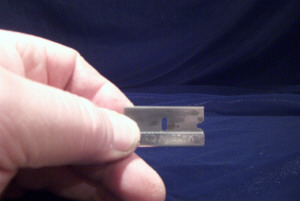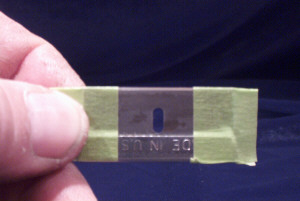 |
|
What do we do when we get the runs ? We go get a razor blade ! NO WAIT, before you run off and do something stupid, read the rest of the article. Disclaimer: As with any tool, a razor
blade doesn't know the difference between flesh and paint, it'll cut BOTH...
be careful !!!!!! Also, if you feel at all uneasy doing this, please
contact someone who can competently carry out this procedure.
|
 |
| First
thing after the lacquer or poly has set up and you discover that nasty run
is to get yourself a single edged razor blade like the one in the first
photo. Now carefully wrap a small piece of tape... I use the Green auto body
type.... around BOTH ends like you see in the second photo. Leave about 3/4"
of exposed blade. Now you're ready. Holding the razor in which ever hand you
happen to be ( Left handed or Right handed ) stand the blade almost straight
up and down, straddle the run with the taped blade, and VERY carefully pull
the blade toward you applying a very slight pressure downward. You can push
as well, but its' harder to see where you're going. Sometimes it helps to
tip the blade ever so slightly toward yourself as you pull. The key is to
NOT apply enough pressure to bend the blade. If this occurs, the blade will
become lower in the center and cut all the way through the run and into the
primer or wood !
The tape serves two purposes, A: It keeps the blade corners from cutting into the good finish, and B: it serves as a depth stop. It will never let you cut all the way to the good finish, UNLESS you bend it in the middle ! If you are skeptical, use two pieces of tape on each side. This is only meant to be used as an emergency finish technique, NOT for every little fleck of paint or dust that shows up on your guitar paint job! If not done properly, this can ruin a finish a LOT faster than any over-sanding of a run could ever do. As with any other technique, practice first before you try this on a good paint job. It does take a bit of practice, but once you get it, you can blast out a run pretty darned clean and fast. One last point, always try to orient the blade so you are on the most level plane. On a round corner or edge you want to cut with the radius NOT over it. If you cut OVER the radius, you will have the radius as the high spot and probably cut to the wood. Happy building... er, repairing.
|
 |